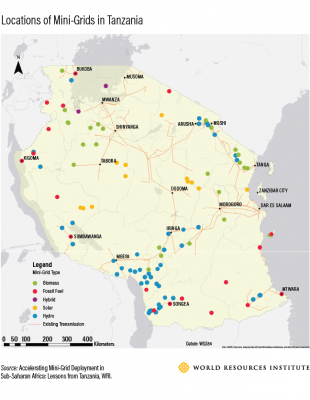Lessons from a comprehensive study of minigrids in Tanzania could help to speed up their deployment in sub-Saharan Africa.
So concludes a report from the Tanzania Traditional Energy Development Organisation (TaTEDO) and World Resources Institute (WRI) on the first major survey of the country’s minigrid sector.
Minigrids are small-scale electricity generation and distribution systems of less than 10 megawatts (MW).
 The number and capacity of minigrids in Tanzania have doubled since new policies were introduced in 2008.
The number and capacity of minigrids in Tanzania have doubled since new policies were introduced in 2008.
Credit: WRI
Help to ‘transform energy access’ in Africa
Many communities in Africa, where hundreds of millions of people have no electricity, are banking on minigrids to “transform energy access” and remove a major barrier to socioeconomic progress.
The International Energy Authority and the United Nations have said that building 100,000-200,000 minigrids could bring electricity to an estimated 140 million rural Africans by 2040.
However, there are many hurdles to be overcome, such as lack of information, investment, policies, and frameworks.
The new report suggests that Tanzania’s leadership in the minigrid sector offers valuable lessons in how this might be done, particularly in in sub-Saharan Africa, where more than 60 percent of people have no access to electricity.
Policies and frameworks
In 2008, Tanzania brought in new policies and regulations to encourage investment. Part of this was a Small Power Producers (SPP) Framework.
Since then, the number and capacity of minigrids in Tanzania have doubled: 52 minigrids with more than 67 MW of installed capacity were commissioned and built between 2008 and 2016.
[advert]
At the start of 2016, there were at least 109 minigrids, spread across 21 regions, serving around 184,000 customers in mainland Tanzania.
The installed capacity of minigrids in Tanzania totals 157.7 MW generated from fossil fuel, hydro, biomass, solar, and hybrid energy sources. This compares to a central grid with a capacity of around 1,500 MW, generated primarily from natural gas and hydro power, that serves around 9 million people.
Decentralized electrification option
The government sees rural electrification as key to helping Tanzania reach middle-income status by 2025.
Tanzania is a large country with a low rural population density, so it does not make economic sense to extend the national grid to the many isolated rural communities.
The authorities estimate that decentralized electrification, as opposed to expansion of the central grid, is a more cost-effective option for around half of the rural population.
“As we collected data for this report, we saw how minigrids can support schools, health clinics, and small businesses in Tanzania’s rural communities,” comments Estomih Sawe, executive director of TaTEDO.
Diesel minigrids currently most attractive option
The report documents many aspects of the nature and types of minigrids in Tanzania.
For example, it notes that hydro is the most common source of power, and is used by 49 minigrids. However, while only 19 minigrids use fossil fuels, they account for 93 percent of customer connections and nearly half of total installed capacity.
 The installed capacity of minigrids in Tanzania totals 157.7 MW. Credit: WRI
The installed capacity of minigrids in Tanzania totals 157.7 MW. Credit: WRI
Of the other minigrids, 25 are biomass-, 13 are solar-, and 3 are hybrid-powered (for example, using solar and diesel power). There are no wind-powered minigrids in Tanzania.
The report suggests that while there are challenges in maintaining plants and getting hold of spare parts in remote areas, it is likely that diesel minigrids offer the most attractive option as they are well understood, less expensive to build, and can generate power on demand.
Science, sharing, and support
Lack of investment and information about minigrids pose key challenges for developers and policymakers, the report concludes. Among its recommendations it calls for more scientific research on the impact of minigrids in rural communities, and more sharing of information, for example on a database of detailed minigrid characteristics.
The report also advises that building and maintaining minigrids requires a lot of support, “particularly at the local level.” This should include the “technical, business, and management skills” that potential developers need to produce plans and secure finance.
[ad2]
Support is also needed in all the phases of capacity building: “including the design, procurement, construction, and management of plants.” In addition, the bidding system should allow for “sufficient competitive bidding between high-quality developers,” and there should be support for local bidders to build capacity so they can participate.
“Minigrids have the potential to be a transformative solution for sub-Saharan Africa as informed investors and ambitious government targets are aligning to make rapid growth possible,” says Andrew Steer, WRI president and CEO. “Now is the time to act.”

